And now for some good news…
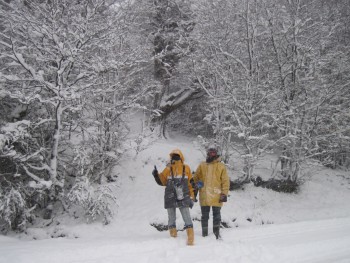
Various friends have written to us in the course of the past few weeks, asking how we’re faring at “the uttermost end of the Earth” now that Spring is in the air. Well… all I can say is, Spring has not sprung! Last week the village of Puerto Williams was once again buried under a foot of snow.
I have a dim recollection of crunching my through something similar at about the age of seven. This kind of thing happens so seldom in southern England that everything immediately grinds to a halt and the newspapers scream, “Snow sweeps the South! Sussex struck by blizzard! Commuters forced to spend three hours trapped inside their cars!”
Meanwhile, down here, where snow might fall in any month, the people just get on with life. In Chile, nature is not always the cuddly, caring mother that she’s supposed to be, and they’ve got bigger things to worry about than a white-out. We had our first little taster of one such worry just last week:
It was approaching midnight, and we had just stoked the fire and were preparing to turn in when Caesar’s phone suddenly commenced to scream. That, at any rate, is the best word I can find to describe the electronic noise which it produced. While the rest of us passed such remarks as, “What the f— have you done to your ring-tone?”, Caesar simply looked astonished. He picked up the phone, stopped the racket, and read the screen. Then, still with a look of surprise, now mingled with disbelief, he said, “That was a tsunami warning!”
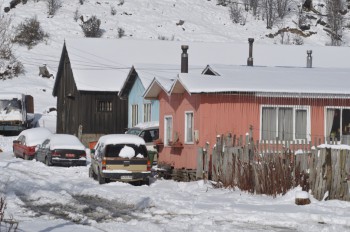
There was a moment’s silence while we all digested this information. The day that we arrived in Puerto Williams a volcano went off in rather a big way, spewing orange fire into the sky and spreading ash over towns on either side of the Andes. Nobody was hurt, so far as I am aware, but this event brought home to us the fact that Chile is actually a rather precarious sort of a place. Eruptions are an almost weekly event – and I mean that quite literally; there’s almost always a volcano sniffling or spitting away somewhere along the mountain chain of which this country consists. Earthquakes are also commonplace, and tsunamis, as we all know, are the product of a quake. So…
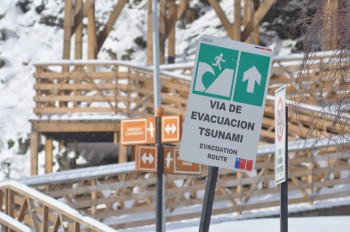
With high drama an everyday possibility, the Chilean government has come up with a system whereby, whenever there is an earthquake or a volcano, every phone in the affected area receives a message; and the arrival of the message is announced by the electronic siren which we had just heard. Besides issuing warnings, the authorities also organise evacuations, and to this end, in every seaside street in every coastal town in the country there are signs telling the people where to go in the event of disaster. I had noticed these signs when we first arrived in Puerto Williams and walked to the Port Captain’s office to clear in, and I had questioned one of the officials as to their need. “You couldn’t really get a tsunami in here, could you?”
“Impossible!” he agreed.
So…
Of course, if one were anchored in a remote caleta, far from a cell-phone mast, then the tsunami warning would go unheard, and the deadly wave really could arrive unannounced… and it could do a lot of harm. But alongside the Micalvi (an old wrecked ship which forms a pier and a club-house for yachts visiting Puerto Williams) we had a phone signal and we had internet access. So, we promptly turned on the computer and went online; and we discovered that there was, indeed, an earthquake happening. It was in the north of Chile, in the vicinity of the capital city, Santiago. The first shock had measured 8.3 on the Richter scale, and there were still ripples, or after-shocks, occurring. We were astonished at the speed with which the Guardian and the BBC had produced their reports. After all, the first tremor – the big one – had occurred only about five minutes before we went on-line!
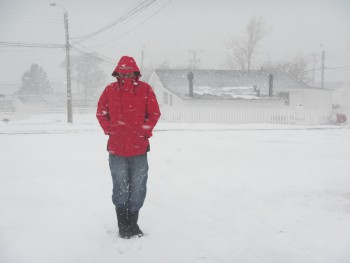
It just so happened that our good friend, Gean, was passing through Santiago that night on his way to join us. I sent him a quick message – (Isn’t Facebook a wonderful thing!) – and after a brief delay, during which I began to fear the worst, he affirmed that the buildings in the city were swaying.
“It’s very strange…” he wrote.
“Get under a table!” I ordered him.
(It turns out that this is bad advice, by the way. The thing to do is get out into the street.)
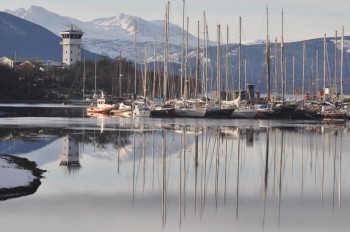
By now we had also turned on the VHF and, sure enough, after a few minutes more it crackled into life and an excited voice shouted, “Securite, securite, securite, securite, securite, securite!” It then proceeded to advise all vessels moored in Puerto Williams to move out into the middle of the channel, where the water is more than 150 metres deep. This made good sense – if there really was a tsunami coming…
“Forget it!” I said (just in case anyone else was thinking of obeying the instruction). It was midnight, it was snowing, and it was blowing so hard that earlier in the day the port had been closed. Moreover, Nick was in the midst of servicing the engine and so it was not in working order. Obviously, if there really was a tsunami coming then we would think little of sailing to and fro all night in a force six blizzard, dodging all the others who were employed in the same activity… but if there wasn’t, then we might as well stay put.
“How could a tsunami get up here?” I asked Nick; and he, after perusing the chart, was in agreement with me. The tsunami would have to travel 1,000 miles down the coast – which would be easy – but it would then have to worm its way around the bottom of Isla Londonderry and wriggle all the way along the Beagle Channel.
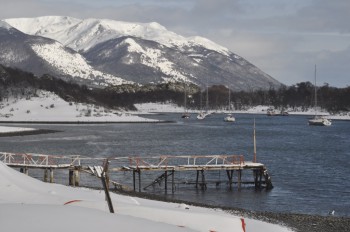
The manic voice burst into the cabin again, repeating its warning and its advice – get into deeper water, where the tsunami cannot affect you! – but we went to bed. For what it’s worth, none of the other yachts heeded the warning either, our fellow Sea People having evidently arrived at the same conclusion, and the only boats which moved to the centre of the channel were the naval vessels. Their captains had no choice but to obey the injunction.
There was no tsunami in Puerto Williams, but if this tale comes across as being disrespectful of the Chileans – if you think that I’m mocking them or suggesting that they are prone to high drama – be reassured; I’m not; far from it. So far as I can gather, Chile’s earthquake pretty soon fell out of the international news, the reason being that not enough people died… But that doesn’t mean that it was a non-event!
The world’s worst ever recorded earthquake measured 9.3, and that one was also in Chile. It occurred in 1960, and it was followed by a tsunami and then, a few hours later, by a massive volcanic eruption. The town of Valdivia was knocked to the ground by the first event, swept by the second, and buried by the third. (There, and you thought God hated Sodom and Gomorrah!) The death toll was around 5,000. In 2010 another big quake killed 700 people, and on that occasion four Chilean officials were imprisoned for failing to do their duty and warn the populace in good time. I guess that was when the advance warning system was introduced. And I guess that’s why, on this latest occasion, the authorities took good care to warn anyone who might be even remotely at risk.
When this recent earthquake happened, just ten miles off the coast of Illapel, the scientists promptly identified the tsunami threat and they evacuated one million people. And as a result, when the 15ft wave rolled in, as predicted, and damaged 200,000 homes, there was no one around. The combined death toll from the quake and the tsunami was just thirteen – and that’s why it’s no longer on the telly in Europe.
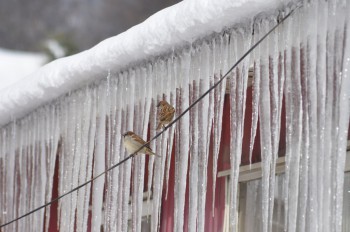
As a result of the earthquake there are now 9,000 homeless people in Chile, but their government is coping with the problem. Myself, I reckon that this “non-event” is actually very newsworthy! Here’s a government which, with only twenty minutes warning, managed to save one million lives! Can you imagine the American or the British government managing that kind of feat? I seem to recall that last winter in England there were whole villages flooded due to a lack of preparation and foresight, and the refugees were helped not so much by the authorities as by the charitable donations from other citizens. Meanwhile, the US didn’t fare too well when Hurricane Katrina rolled in, and that despite more than 48 hours warning.
This recent quake was around 500 times stronger than the one which killed 150,000 people in Haiti in 2010, and bigger even than the one earlier this year which killed 9,000 people in Nepal – and yet it only cost 13 lives. I think the Chilean government rocks! – and I think it’s time the BBC et alia started reporting good news alongside their tales of Syrians drowning and suchlike.
(Edit: Since I penned this article the Guardian has, in fact, come up with a very nice article called How did Chile survive the earthquake virtually unscathed?)
Looking ahead
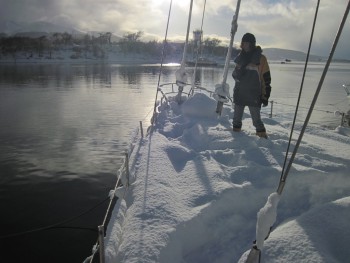
Next week we’re going to share with you the story of a little journey made aboard a friend’s boat. Gondwana is Chilean flagged, and so she can venture into waters which are off-limits to foreign vessels. The taboo area includes an important archaeological site – a village which was still flourishing when it was visited by Robert Fitzroy and Charles Darwin, and which was subsequently the scene of a massacre, by the natives, of the first Christian mission. It was to this historic venue that we sailed, in the middle of winter, in the snow.
(P.S. It’s stopped snowing! Since I wrote this article, a few days ago, the weather has warmed up a tad, the snow has vanished, and I think Spring really is just around the corner.)
